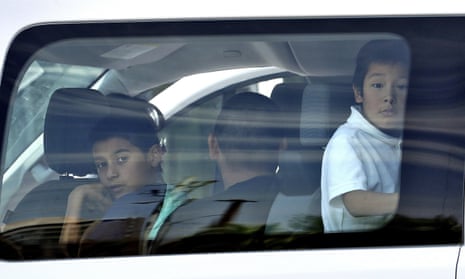Mass family separations have ended, but hundreds of children remain in the US separated from their parents in the wake of the harshest US immigration policy in decades.
When – and how – these 572 children will see their parents again is a mystery as the government attempts to foist the responsibility of reunification on advocacy groups. Many of them risk being in effect “orphaned” in the US.
“What we’re left with is the harder cases,” said the director of the migrant rights and justice program at the Women’s Refugee Commission, Michelle Brané. “My concern is the government seems in some ways to have washed their hands and said ‘we’re done’.”
Q&AHave you been affected by Trump's zero tolerance immigration policy?
Show
We want to shine a light on the lasting repercussions of the policy by telling the stories of those affected, from the migrants themselves to the public employees tasked with implementing assembly-line justice.
Fill the form here to share your story with us.
More than 1,900 families have been reunited, but recently the government drew Judge Dana Sabraw’s ire after suggesting the American Civil Liberties Union (ACLU) and other immigrants rights’ groups should be responsible for reuniting the remaining families, including 410 parents who are outside the US while their children remain in US health department custody.
“The reality is that for every parent who is not located, there will be a permanently orphaned child and that is 100% the responsibility of the administration,” Sabraw said.
Sabraw, who was appointed by George W Bush in 2003, ordered the government to choose one person, or a group of people, to reunify those families as part of the lawsuit brought by the ACLU against the Trump administration.
But reunification is an enormous task.
“There were three agencies, and each was like its own stovepipe. Each had its own boss, and they did not communicate,” Sabraw said at a court hearing on 27 July. “What was lost in the process was the family. The parents didn’t know where the children were, and the children didn’t know where the parents were. And the government didn’t know either.”
The depths with which the agencies were not prepared to handle these separations was made evident by the Washington Post, which said Customs and Border Protection agents had to come up with a category for the families – “deleted family units” – because the databases didn’t have a classification for the children it separated. That information was shared with the health department, which doesn’t have a classification for that group either. So officials went through children’s case files by hand, according to the report.
Of the remaining separated families covered in the lawsuit, 572 children were deemed ineligible for reunification by the government, including 34 whose parents waived reunification, 57 whose parents raised a “red flag”, and 68 whose parents have been released in the US.
Each of these categories is a concern for advocates and attorneys, who allege parents were coerced into being deported without their children or waiving reunification rights or are being held to a higher than usual standard for what constitutes a “red flag”. They also don’t know how to move forward on immigration cases of children who are in US custody but who have not found their parents – who may want them to stay in the US for safety reasons.
The ACLU, which sued the Trump administration in March, has repeatedly requested more information on these individuals from the government and said there is only so much it can do without the information. “Every day the government has sat on this information has been another day of suffering for these families,” said the ACLU attorney Lee Gelernt.
Children who have not been reunified with their parents sit in health department shelters, waiting to be put in the care of another parent, close relatives or other sponsors.
These shelters usually house children who crossed the border on their own, with the intention of meeting their parents or other relatives in the US, and children separated from parents because the government determined the adult posed a risk to the child’s welfare.
The Trump administration policy has changed things, however, and now these shelters include significantly more people who crossed the border with their parents than before.
Because these children have been separated from the person they would normally be reunited with in the US, who they end up with is still a mystery.
